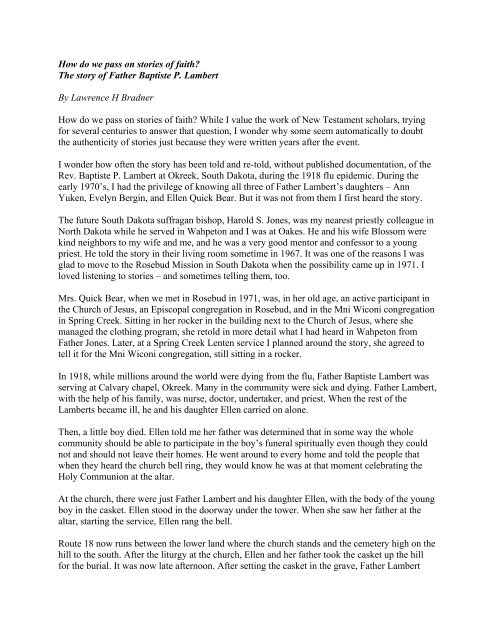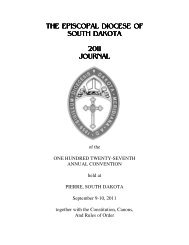The story of Father Baptiste P. Lambert By Lawrence H Bradner How ...
The story of Father Baptiste P. Lambert By Lawrence H Bradner How ...
The story of Father Baptiste P. Lambert By Lawrence H Bradner How ...
- No tags were found...
You also want an ePaper? Increase the reach of your titles
YUMPU automatically turns print PDFs into web optimized ePapers that Google loves.
<strong>How</strong> do we pass on stories <strong>of</strong> faith<br />
<strong>The</strong> <strong>story</strong> <strong>of</strong> <strong>Father</strong> <strong>Baptiste</strong> P. <strong>Lambert</strong><br />
<strong>By</strong> <strong>Lawrence</strong> H <strong>Bradner</strong><br />
<strong>How</strong> do we pass on stories <strong>of</strong> faith While I value the work <strong>of</strong> New Testament scholars, trying<br />
for several centuries to answer that question, I wonder why some seem automatically to doubt<br />
the authenticity <strong>of</strong> stories just because they were written years after the event.<br />
I wonder how <strong>of</strong>ten the <strong>story</strong> has been told and re-told, without published documentation, <strong>of</strong> the<br />
Rev. <strong>Baptiste</strong> P. <strong>Lambert</strong> at Okreek, South Dakota, during the 1918 flu epidemic. During the<br />
early 1970’s, I had the privilege <strong>of</strong> knowing all three <strong>of</strong> <strong>Father</strong> <strong>Lambert</strong>’s daughters – Ann<br />
Yuken, Evelyn Bergin, and Ellen Quick Bear. But it was not from them I first heard the <strong>story</strong>.<br />
<strong>The</strong> future South Dakota suffragan bishop, Harold S. Jones, was my nearest priestly colleague in<br />
North Dakota while he served in Wahpeton and I was at Oakes. He and his wife Blossom were<br />
kind neighbors to my wife and me, and he was a very good mentor and confessor to a young<br />
priest. He told the <strong>story</strong> in their living room sometime in 1967. It was one <strong>of</strong> the reasons I was<br />
glad to move to the Rosebud Mission in South Dakota when the possibility came up in 1971. I<br />
loved listening to stories – and sometimes telling them, too.<br />
Mrs. Quick Bear, when we met in Rosebud in 1971, was, in her old age, an active participant in<br />
the Church <strong>of</strong> Jesus, an Episcopal congregation in Rosebud, and in the Mni Wiconi congregation<br />
in Spring Creek. Sitting in her rocker in the building next to the Church <strong>of</strong> Jesus, where she<br />
managed the clothing program, she retold in more detail what I had heard in Wahpeton from<br />
<strong>Father</strong> Jones. Later, at a Spring Creek Lenten service I planned around the <strong>story</strong>, she agreed to<br />
tell it for the Mni Wiconi congregation, still sitting in a rocker.<br />
In 1918, while millions around the world were dying from the flu, <strong>Father</strong> <strong>Baptiste</strong> <strong>Lambert</strong> was<br />
serving at Calvary chapel, Okreek. Many in the community were sick and dying. <strong>Father</strong> <strong>Lambert</strong>,<br />
with the help <strong>of</strong> his family, was nurse, doctor, undertaker, and priest. When the rest <strong>of</strong> the<br />
<strong>Lambert</strong>s became ill, he and his daughter Ellen carried on alone.<br />
<strong>The</strong>n, a little boy died. Ellen told me her father was determined that in some way the whole<br />
community should be able to participate in the boy’s funeral spiritually even though they could<br />
not and should not leave their homes. He went around to every home and told the people that<br />
when they heard the church bell ring, they would know he was at that moment celebrating the<br />
Holy Communion at the altar.<br />
At the church, there were just <strong>Father</strong> <strong>Lambert</strong> and his daughter Ellen, with the body <strong>of</strong> the young<br />
boy in the casket. Ellen stood in the doorway under the tower. When she saw her father at the<br />
altar, starting the service, Ellen rang the bell.<br />
Route 18 now runs between the lower land where the church stands and the cemetery high on the<br />
hill to the south. After the liturgy at the church, Ellen and her father took the casket up the hill<br />
for the burial. It was now late afternoon. After setting the casket in the grave, <strong>Father</strong> <strong>Lambert</strong>
said the committal prayers and closed his Prayer Book. With his hands and arms raised high on<br />
either side, the priest, in his own words, addressed an impassioned, almost angry plea to God:<br />
“<strong>The</strong>re have been too many deaths! Let there be no more! Let this be the last one!”<br />
As I remember both from <strong>Father</strong> Jones’ version <strong>of</strong> the <strong>story</strong> and from Mrs. Quick Bear’s version,<br />
the little boy’s death was in fact the last death at Okreek due to the 1918 flu.<br />
Some readers <strong>of</strong> this <strong>story</strong> might conclude that at the time <strong>of</strong> the burial, “the natural<br />
epidemiological course <strong>of</strong> the disease in the community was running out and just happened to<br />
coincide with <strong>Lambert</strong>’s prayer. He was a good man, that’s all. In fact, even, a very good man!”<br />
But I suspect that to the people <strong>of</strong> the community <strong>of</strong> Okreek, there was no separation <strong>of</strong> <strong>Baptiste</strong><br />
<strong>Lambert</strong>’s priestly diligence over the years from <strong>Baptiste</strong> <strong>Lambert</strong>’s risk-taking vigor in caring<br />
for the community during the flu crisis or from <strong>Baptiste</strong> <strong>Lambert</strong>’s vigorous, adventurous<br />
outpouring <strong>of</strong> a faith far beyond the dignity <strong>of</strong> established liturgy. I suspect that for this<br />
community, there was no separation <strong>of</strong> all they knew about <strong>Father</strong> <strong>Lambert</strong> and their discovery<br />
that the epidemic was ending.<br />
Most likely there were, before 1918 and since, events which on the surface bore some similarity<br />
to that described here. I once used my VW Squareback as the hearse to carry a large casket from<br />
a wake in a private home, up the steep, difficult trail to the hilltop cemetery <strong>of</strong> Epiphany Chapel,<br />
He Dog, on the Rosebud Reservation. On a cold morning in another Rosebud Mission cemetery,<br />
I joined with a few family members after a very small child died. Any <strong>of</strong> us could have lifted the<br />
casket alone; all <strong>of</strong> us joined in the digging <strong>of</strong> the grave and its covering. But none <strong>of</strong> these<br />
events had the same power that the Okreek <strong>story</strong> has.<br />
It must be the power <strong>of</strong> the 1918 events at Okreek and the power <strong>of</strong> that <strong>story</strong> that have propelled<br />
its retelling across almost 90 years without, so far as I was able to see, any published retelling <strong>of</strong><br />
it. I punched in all the Google possibilities I could think <strong>of</strong> and found nothing!<br />
<strong>The</strong> <strong>story</strong> had a very strong effect on me regarding my eagerness to serve on the Rosebud<br />
Mission. But every now and then since my 1975 return to my home diocese <strong>of</strong> Rhode Island, I<br />
have told the <strong>story</strong> to grateful listeners.<br />
As I came to the close <strong>of</strong> this narrative, thanks to the wonders <strong>of</strong> e-mail, I received the Rev.<br />
Frederick Jessett’s recently written, more extensive narrative <strong>of</strong> the 1918 Okreek events derived<br />
from his conversations with scholar Ella Deloria in the 1950’s and conversations with Mrs.<br />
Quick Bear. I decided not to use any <strong>of</strong> <strong>Father</strong> Jessett’s version to alter mine, but just finish mine<br />
as originally planned.<br />
Fred Jessett became acquainted with Mrs. Quick Bear a few years before I did. For several years<br />
near the end <strong>of</strong> his tenure on the Rosebud, he and I served together and shared acquaintance with<br />
Mrs. Quick Bear simultaneously. But she gave her narrative to each <strong>of</strong> us separately, at different<br />
times.
In the Episcopal congregations <strong>of</strong> the Niobrara Deanery <strong>of</strong> South Dakota, women and men <strong>of</strong> the<br />
congregations were continually telling and retelling stories with great wit and sometimes tragic<br />
depth at suppers, all-night wakes, and church business meetings. In the churches <strong>of</strong> the Rosebud<br />
Mission, such <strong>story</strong>telling is commonplace and is one <strong>of</strong> the strengths that has held the Church in<br />
South Dakota together during extremely challenging circumstances over about 150 years. In this<br />
respect and others, these South Dakota congregations are very much like those <strong>of</strong> the first<br />
century <strong>of</strong> the Christian era.<br />
In the Okreek <strong>story</strong>, I know firsthand several versions: that <strong>of</strong> Harold Jones, the briefest form;<br />
that <strong>of</strong> Frederick Jessett, Ella Deloria, and Ellen Quick Bear, the longest; and my own telling, <strong>of</strong><br />
middling length. <strong>The</strong>re are some “factual” differences, but in all three versions the narrative <strong>of</strong><br />
the core events is the same.<br />
Not with any sense that my version is more accurate than that <strong>of</strong> <strong>Father</strong> Jessett, I record my final<br />
impression <strong>of</strong> <strong>Father</strong> <strong>Lambert</strong> in the cemetery as I remember his daughter Ellen telling it to me:<br />
“<strong>The</strong> sun was setting to the west <strong>of</strong> us; with <strong>Father</strong>’s arms and hands outstretched and his jacket<br />
hanging from his arms on either side, the setting sun cast a shadow on the ground that looked<br />
like an eagle’s wings.”<br />
<strong>Lawrence</strong> H. <strong>Bradner</strong>, a retired priest, is historiographer <strong>of</strong> the Diocese <strong>of</strong> Rhode Island.<br />
Published in <strong>The</strong> Historiographer <strong>of</strong> <strong>The</strong> National Episcopal Historians and Archivists and <strong>The</strong><br />
Historical Society <strong>of</strong> the Episcopal Church.



